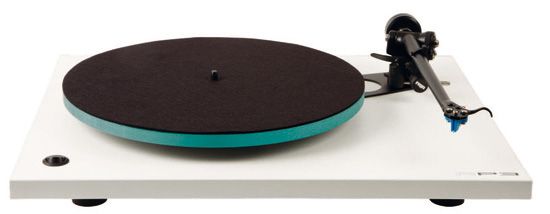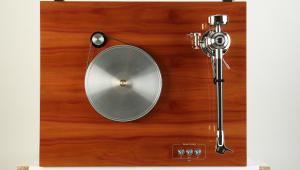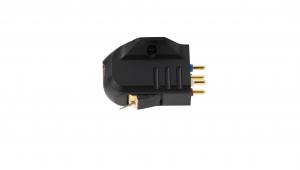Rega Rp3 (£549 W Elys 2 Pick Up)

Rega’s philosophy is that while the plinth has to be as rigid as possible, it also should be as light as possible. And seeking to maximise the plinth’s rigidity between tonearm and main bearing, a phenolic stiffening brace is added. On the RP3, the brace visible on top of the plinth is complemented by a second one below, forming a stressed beam assembly. The actual plinth is a piece of special light furniture board, finished to a very high standard by something akin to a printing process.
As for the arm, the new RB303 looks much the same as the former RB301, but in fact has been redesigned and re-tooled. The bearing housing area has been given more rigidity, and the bearings are placed further apart. Also, the back end is slightly heavier and the headshell end slightly lighter. This ‘intelligent redistribution of mass’ has improved the arm’s resonant behaviour, says Rega. In addition to the new arm tube, the RB303 has a stronger arm carrier or mounting part.
Exactly as with the P324, Rega offers optional upgrades for the standard small plug-top power supply with a dedicated unit, giving electronic switching between 33.3 and 45rpm, and you can treat your RP3 to a more accurately made belt, with more perfect roundness of section and less unwanted flash.
Our RP3 came complete with Elys 2 moving-magnet cartridge. It has an elliptical stylus and tracks at 1.75g. With the cartridge factoryfitted, leaving just tracking force and bias to be set, the turntable was soon ready to ‘plug in and play’.
MIDRANGE CLARITY
It’s hardly surprising that the RP3 did a great job on Rega’s own audiophile recording, Christine Collister’s Love [ENS 002]. In the opening ‘Time In A Bottle’ its great midrange clarity and freedom from smearing really helped Gary Bennett’s guitar to glow, while his banjo sounds came to life with tangible placement in the soundstage. The cello, which provides the underpinning bass line on this track, sounded clean and in better proportion than on some systems, where it can stick out a bit awkwardly. At the same time, Collister’s delivery had an expansive quality, the vocal brought forward with a sense of good breath and lip detail. The backing vocals were well presented too, with a clear definition of individual voices.
Next, we put on Blondie’s Parallel Lines [Chrysallis CDL 1192]. The RP3 was admirably tight and clean-sounding, always delivering the rhythm with conviction while sounding faithful, open and clear in the midrange, giving a window into the production sound so that you felt you could hear how the vocals had got like that.
Eric Clapton’s Backless showed the Rega’s ability to give you a coherent view of a complex mix of instruments. On ‘Walk Out In The Rain’ it delivered an unusually wellsorted presentation of what can be a rather grungy sound. Carl Radle’s bass line came through with clear and arresting musical logic, and on ‘Watch Out For Lucy’ the whole band swung brilliantly.
Putting on the Elgar Introduction and Allegro with Barbirolli [EMI ASD 521], there was a generally light and open quality as the music progressed. The lower strings were light-footed and explicit without the slightest boom or muddiness. In the midrange, the strings had bite and attack when they needed to, and the effect was to make the playing sound full of verve, not to lead to harshness. There was a good sense of space too.
VERDICT
The RP3’s taut and tangibly ‘right’ bass, and its clear, spacious, uncluttered and inviting sound, makes the best argument for Rega’s design philosophy. With or without the Elys, the RP3 represents outstanding value.























































